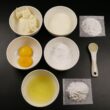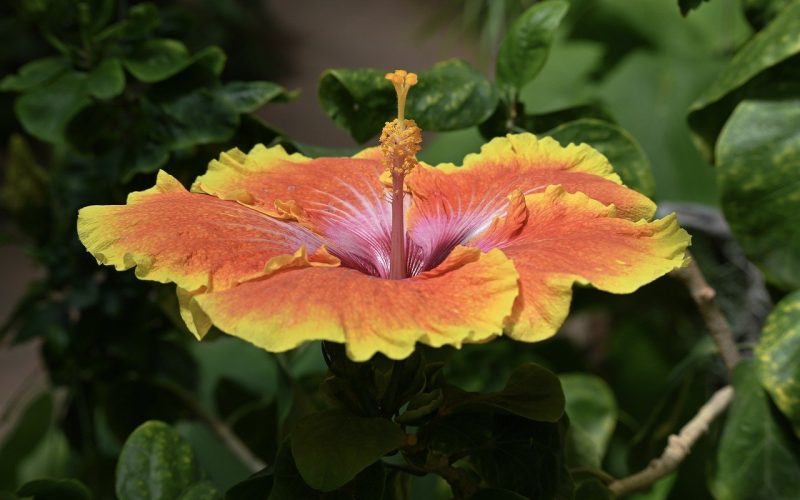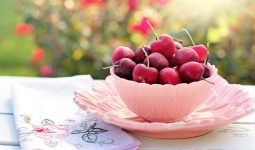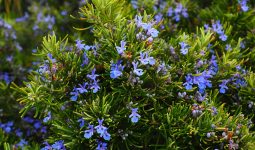Have you ever stopped to admire the beauty of a hibiscus flower? Did you know there are many different types of Hibiscus, each with unique characteristics and uses?
From the classic red Hibiscus to the less popular white Hibiscus, there is a wide variety of these stunning plants to explore.
Hibiscus is a flowering plant species native to warm, temperate, subtropical, and tropical regions worldwide.
They are famous for their large, colorful flowers and are commonly used for ornamental purposes and in traditional medicine and cuisine.
If you are a fan of Hibiscus or simply curious about the different types of this beautiful plant, you have come to the right place.
In this article, we will explore the different types of Hibiscus, their unique features, and how they are used worldwide.
Whether you are a gardener or a flower enthusiast, this article has something for everyone.
Different Types of Hibiscus
1. Rock Hibiscus
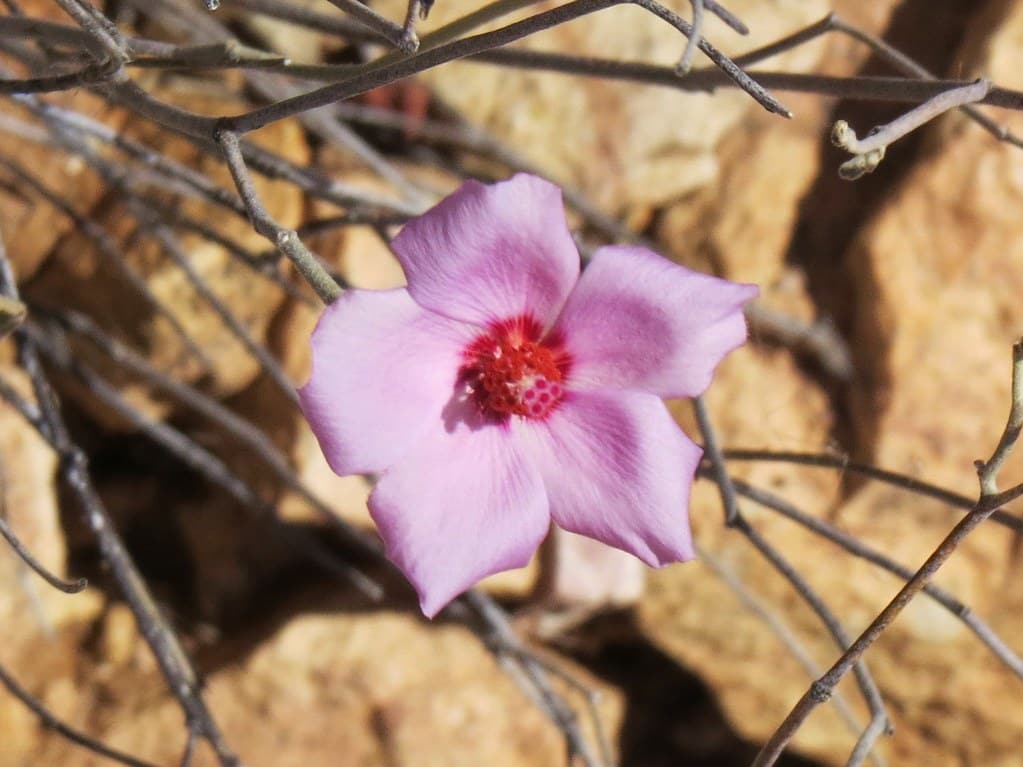
The Rock Hibiscus, scientifically known as Hibiscus denudatus, is a shrub that is native to both Mexico and the United States.
It’s famous for its gray triangular foliage and flowers ranging in color from shades of white to deep purple and pink.
And we can find this beautiful plant mostly on rocks, earning it its popular name.
The Rock Hibiscus is a versatile plant; it does not need much upkeep or care to remain healthy and beautiful.
Its thin but strong leaves make a remarkable contrast against other dense foliage plants when decorating an outdoor garden.
Further, its flowers attract certain species of hummingbirds. Thus, it adds another level of nature to any garden space.
2. Blue Bird
Blue Bird is among the different types of Hibiscus that got its name from its dazzling blue flowers.
This shrub will quickly add a splash of color to any garden, making it stand out among other plants.
Growing up to 4 feet in height, the Blue Bird Hibiscus has large cup-shaped petals that can grow up to 3 inches wide.
With their bright blue hue, these blooms can hold their own against other varieties and bring an instant appeal to any landscape.
The Blue Bird hibiscus is the perfect choice for gardeners looking for low-maintenance plants. This tough shrub won’t give you headaches even during long dry spells, as its roots are highly drought-resistant! All it needs is plenty of sunshine and regular watering to get it through each year.
As a bonus, you don’t have to worry about pesky pests infecting this plant as it isn’t attractive to them like some other flowering plants are.
3. Rose Mallow
Though uncommon, the Rose Mallow is among the different types of Hibiscus. Its botanical name is Hibiscus moscheutos, and it features colorful blooms in shades of pure white to deep rose. These large, beautiful flowers have 10-12 inches-wide petal pads, velvety textures, and dark centers.
Also, the foliage of the Rose Mallow is usually dark green and glossy, making for an enhancing contrast against the multiple colors of the blossoms.
Its bright yet calming presence creates a peaceful atmosphere wherever it’s planted, whether clustered between plants or alone in a garden feature landscape. It requires little maintenance overall, and its care instructions are rather simple. You only have to keep the soil moist but well-draining and give adequate sunlight exposure to stimulate their vibrant blooms.
4. Abelmosk
Abelmosk is an annual variety of Hibiscus native to India. It is a strong and tall plant that can grow up to 5-6 feet tall. Its flowers have bright yellow-lime green petals with large centers giving it a unique look.
What sets this species apart from other flowers is its pleasant musk-like fragrance, with the bonus of its seeds being useful in coffee.
Due to its height and invasive nature, Abelmosk makes a great option for those wanting to add greenery to their garden without taking up much space. Alternatively, they can grow it in pots, although some might consider this an unexciting option. Either way, this variety boasts edible leaves and shoots, making it a great source of nutrition.
5. Blush
Another plant among the different types of Hibiscus is Blush. Its popularity has grown partly due to the showy blooms of bright pink and dark red eyes. The vibrant foliage, with a wine-red hue and the ruffled texture of the petals, can add texture and color to any garden scene.
This compact plant grows between two and three feet tall with an additional spread of up to four feet at full maturity. It is ideal for borders in the garden or large containers of mixed colors, giving visual interest from early summer through late fall. Also, their hardiness makes them easy to maintain with minimal effort while giving maximum beauty.
So, if you’re looking for a bright addition to your yard that doesn’t require much work, look no further than the stunning Blush Hibiscus!
6. Black Dragon
The Black Dragon hibiscus is a stunning sight to behold! We can identify this ornamental flower by its deep burgundy hue with an undertone of black.
This versatile flower can grow up to 3-6 feet tall and flourish in full sun or partial shade. It produces ruffled blossoms four to five inches wide, tinged with a slight golden glow around the edges. They make beautiful cuttings that keep their color in water for longer than a week, making them great décor additions to any home or garden.
With minimal care and maintenance, you can be sure that this magnificent bloom will keep your outdoor living space looking vibrant for months!
7. Flower of an Hour
Another beautiful flower among the different types of Hibiscus is the Flower of an Hour flower. It grows best in full sun and needs well-drained soil to flourish. The plant can reach 4 or 5 feet tall and produce cream-to-yellow flowers contrasting nicely against the dark green foliage.
Also, the flowers are short-lived and typically only last for about an hour before wailing away, hence the name “Flower of an Hour.”
This flower variety will make a great addition to your garden or outdoor space because of its beautiful blooms and long-lasting foliage. If properly cared for, this plant will bloom in spring and summer. It is visually pleasing and attracts beneficial pollinators such as bees, which help keep your garden healthy.
8. Roselle
Roselle, also known by its scientific name Hibiscus sabdariffa, is a variety of flowering plants native to Africa and parts of Asia. The flowers, with their white to calyces red petals and distinctive red spots, are highly favored for their decorative nature. The entire plant is edible and commonly used as a flavoring agent in food production.
The benefits of Roselle consumption are numerous. High levels of Vitamin C are within its petals; it is also rich in antioxidants like anthocyanins and polyphenols, which protect the body from the damaging effects of free radicals. Apart from these nutritional benefits, Roselle helps reduce the risks of hypertension while improving digestion due to its high dietary fiber content.
Its calming properties make it an ideal remedy for mild headaches or general mental fatigue. As such, Roselle has become a medicinally and culinarily popular ingredient worldwide.
9. Kenaf
Kenaf is one of the different types of Hibiscus belonging to the Malvaceae family. It is widely used as a fiber crop for making jute and has red flowers with a diameter of up to 4 inches. It is native to some countries in Africa and India and typically grows well in hot climates with lots of sun.
Compared to other crops, Kenaf grows quickly, as it can reach full maturity within four months of cultivation. Due to its fast growth, it’s an ideal crop for farmers interested in sustainable agriculture practices since it does not require large amounts of land or water usage. In addition, its fibers are resilient and versatile enough for different types of applications, such as bags and carpets.
Consequently, Kenaf production delivers superior quality at a low cost compared to other jute-producing plants like ramie or flax. Farmers worldwide can also benefit from Kenaf farming due to its multiple uses as a dual-purpose crop. Apart from producing quality fibers and fabric, its seeds can also be used as feed for livestock.
10. Aphrodite
Aphrodite is a majestic flowering shrub that blooms in mid to late summer with exceptional beauty. It has large and luminous pink petals with yellow centers, giving the blossoms an elegant contrast. Also, its velvety green foliage perfectly complements the vibrant deep fuchsia-colored flowers, creating a stunning canvas of bright and lively colors.
This species of Hibiscus appreciates well-drained soils but can adapt to various soil types as long as they are evenly moist. Every few years, pruning should occur after flowering as this will help promote skin wood growth. It is resilient against pests or diseases and adds exotic charm to any landscaped garden with its cheerful deep pink flowers from early spring through fall.
11. Luna Red
The Hibiscus moscheutos’ Luna Red’ is a beautiful and vibrant ornamental plant with a unique five-petaled flower. It is a fast-growing, hardy flower that prefers well-drained, fertile soils in full-to-part sun locations. Growing up to two feet tall and three feet wide, this mounding shrub will bring life and energy to any garden.
The unique bloom of the Hibiscus luna red features bright red petals with an orange center surrounded by bright green foliage. Depending on the climate zone, these perennials may die back to the ground each winter, then reward their diligent owners with new blooms year after year. A great choice for borders or beds, their drought tolerance makes them the perfect pick for sunny spots throughout the landscape.
12. Beach Beauty
Another hibiscus flower among the different types of Hibiscus is the Beach Beauty flower. It’s famous for its eye-catching array of colors and large blooms. This hibiscus flower produces flowers between 6-8 inches wide and displays various shades of colors.
Those fortunate enough to have a big garden area or outdoor space will find that the Hibiscus’ Beach Beauty’ grows quite vigorously up to 15-20 feet tall. It can be used as an evergreen shrub or trellis climber. Even for smaller gardens, it still provides plenty of stunning beauty and attracts beneficial wildlife like butterflies.
13. Secret Heart
Secret Heart features delicate, vibrant blooms with striking shades of pink and red in cooler climates, which gradually open to a stunning blue color when the weather is warm. The blossoms have five petals that form a heart-shaped flower pattern when fully opened. Thus, it gives true justice to its common name, Secret Heart.
Because of its love for alkaline soil, we can grow this hibiscus outdoors and indoors. When planted outside, it produces beautiful greenery year-round in warm areas. It has a moderate growth rate and can reach heights over 6 feet, depending on where it is planted.
In addition to its attractive appearance, Secret Heart is resistant to pests and diseases. Thus, it’s an ideal choice for gardeners looking for an easy-care plant to enhance their outdoor or indoor space.
14. Lord Baltimore
The Hibiscus ‘Lord Baltimore’ is an attractive herbaceous perennial that offers beauty and function to any garden. This plant can grow up to 4-5 feet tall with large, bright red flowers and glossy green leaves providing visual interest year-round. The eight to ten-inch wide petals are ruffled at the edges, adding an interesting texture to the flowers.
From mid-summer to early fall, these blooms appear on leafy stems, vibrant and providing a pop of color to any landscape.
This species of hibiscus also makes an excellent cut flower for vases or floral arrangements due to its long-lasting quality when cut from the bush. When in bloom, it produces a subtle sweet smell enticing for pollinators such as butterflies and hummingbirds that beeline for its beauty.
Lord Baltimore does best in full sun and moist, well-draining soil. Thus, it’s ideal for garden beds or borders where it will enjoy sunlight exposure throughout the day.
15. Rose of Sharon
Another interesting flower among the different hibiscus types is the Rose of Sharon. Also known by its botanical name Hibiscus syriacus, Rose of Sharon is a gorgeous shrub with flowers that bloom in late summer to mid-fall. It’s a popular ornamental shrub due to its lovely blossoms, which come in various colors, including purple, white, and violet.
With proper pruning and care, this shrub will bear larger blooms and maintain its curvy shape. To plant the Rose of Sharon, choose an area that gets full sun for at least 6 hours each day, although it does have some tolerance for partial sun locations. Dig the hole twice as wide as needed for the Rose of Sharon root ball and set the crown to rest just above ground level.
Further, water thoroughly throughout the spring and summer since this will help with flower production later. Even though they are low-maintenance plants, they need yearly pruning to keep them happy and healthy and maintain their desired size.
16. Rose Mallow
Rose Mallow is a unique and eye-catching perennial flowering shrub. Its botanical name is Hibiscus moscheutos, and it can grow up to 3-8 feet tall. This multicolored beauty boasts delicate petals that range from pure white to deep rose with a maroon center.
They typically measure 10-12 inches across and are offset by the dark green foliage. The Rose Mallow blooms open in the summer, continuing until fall.
This readily available ornamental flower provides beauty to gardens of all shapes and sizes. Also, it attracts beneficial wildlife like hummingbirds and butterflies that help support the general balance of nature.
Rose Mallows need minimal maintenance. So, they’re great options for gardeners not looking for an overly demanding plant life addition to their outdoor areas.
17. Exuberance
Although rare, Exuberance is one of the different types of hibiscus. It showcases gorgeous, vivid colors that bring an exuberant and cheerful feeling to any outdoor environment. Also, it is a hybrid between ‘Saffron’ and ‘Fireball,’ producing large multicolored flowers 7-9 inches wide.
With each bloom exhibiting different shades, you can almost forget the worry of boredom setting in with regular flowering plants. Moreover, growing this shrub is simple, as it will thrive in full sun or partial shade. Just be sure your Hibiscus ‘Exuberance’ has plenty of good soil and consistent moisture to keep it thriving.
18. Mango Liqueur
Mango Liqueur is an exceptionally beautiful and vibrant flowering plant with a tropical twist. Originating from its parent plants, the ‘Muffin Man’ and ‘Crème de Cacao,’ this Hibiscus rosa-sinensis hybrid has large ruffly flowers. And they range from 6 to 8 inches wide in vibrant shades of orange and gold.
It also grows tall, reaching a maximum height of 10-12 feet, making it a great addition to large gardens or outdoor spaces. With their unique colors and form, Mango Liqueurs make excellent additions to garden designs or outdoor landscaping projects.
Due to its colorful, showy floral display, Mango Liqueur plants are often used as decorations and centerpieces on special occasions, such as weddings or parties. Not only do they bring brightness and beauty to any event, but they also serve as great conversation pieces among guests.
19. Coccineus
The Hibiscus Coccineus, also known as the Texas Star Hibiscus, is a rare species among the different types of hibiscus. It’s an upright woody plant with lush green leaves that will create quite the natural focal point in your garden.
This specimen produces red flowers approximately three to four inches in diameter during its blooming period. Thus, it’s an excellent choice for attracting butterflies and hummingbirds to your garden. These flowers will surely add beauty to any outdoor space when grown correctly.
Coccineus prefers a full-sun location but tends to be vulnerable to cold and frost conditions. You must provide additional protection from extreme temperatures to get the most out of this stunning flower. Keep the soil moist throughout its growth cycle to reach its full potential.
However, if properly cared for every year, this plant will surely reward you with beautiful red blooms all summer!
20. Giant Rose Mallow
The flower petals of the giant rose mallow are soft and satiny, surrounded by large copper-purple foliage leaves with a glossy shine. Also, it is a warm-season plant, boasting abundant blooms throughout the hotter months from midsummer till the frost of fall.
Giant Rose Mallow relies on full sun to thrive, preferring moist soil and mulch to maintain normal hydration levels. Despite being native to swampy areas of Missouri, this species is quite tolerant to dry conditions as long as it has access to a good amount of water.
Giant Rose Mallow does not require planting in a pot; dig up some soil and bury your cutting or seeds at least 4 inches deep for best results. When grown in its preferred location, the bush will reach heights between 4 to 6 feet tall and wide! Proper maintenance, such as pruning back old blossoms, can be kept in check size-wise or allowed to develop into impressive stature when given enough nutrients and space.
21. Checkered Hibiscus
Among the different types of hibiscus is the Checkered Hibiscus. It is a deciduous shrub that grows in wetlands, lakesides, marshes, and other moist areas with good drainage. The plant produces wonderfully colored flowers with creamy-white centers ringed in pink or red.
Each flower has eight petals and can reach 4-5 inches wide when fully grown. As each flower fades away, a seed capsule appears to replace it.
These plants prefer well-drained soil and full to partial shade, but they can also survive in dry, sunny locations as long as the soil retains some moisture. Hibiscus moscheutos will bloom from early summer until late fall and can be pruned back after flowering. Moreover, they attract bees and butterflies who help pollinate their flowers throughout the season.
For best results, give your checkered hibiscus plenty of room to spread out its branches so that each one may display its incredible beauty in all its glory!
22. Confederate Rose
The Confederate Rose, or Hibiscus mutabilis, is an attractive garden or patio accent for any home. Native to China and parts of the South Pacific, its double flowers ranging from pink to white blooming from late spring to early autumn, are a sight to behold. Growing to 4-6 feet tall and wide, this lovely shrub features star-shaped flowers with unique characteristics.
Confederate Rose needs full to partial shade and well-drained soil to thrive in any environment. This plant’s spectacular display makes it suitable for providing color and interest in all types of landscapes, whether you choose a more traditional garden setting or let it climb up a trellis against a wall. And its long flowering season means you can enjoy its beauty year after year.
23. Moscheutos
The Hibiscus moscheutos is also among the different types of hibiscus. Depending on the variety, this perennial shrub can grow between three to eight feet long at maturity and will have various colors, like deep rose, pure white, and maroon. It has plate-sized blooms with petals that can reach twelve inches across, accompanied by dark green foliage and yellow stamens.
Moreover, the flowers are in full bloom from summer until the first frost giving viewers several months of beauty as they witness the naturally occurring color palette they create.
Though native to marshes and wetlands, the Hibiscus moscheutos is now a common sight throughout many gardens due to its low maintenance requirements. Its toleration for most types of soil means you don’t need to put too much effort into giving it a proper environment for growth. All you have to do is plant some bulbs or cuttings in the garden, water them occasionally, and watch as you get rewarded with an ever-changing display of colors.
24. Trionum
The Trionum is a hardy, attractive hibiscus plant perfect for formal gardens and garden borders. It reaches an ideal height of approximately five feet and offers an eye-catching combination of blood-red centers with ivory petals on its flowers. Also, its dark green leaves have very distinct lobes, giving it a unique feel in more modern settings.
This particular hibiscus thrives in areas that experience moderate temperatures throughout the year, such as in most parts of the United States. Although it has become somewhat recognized as a weed in some areas, it is still popularly sought after as an accent plant among gardeners. The Trionum holds high merits for anyone looking for ornamental and functional additions to their garden!
25. Bedazzled
The last on our list of the different types of hibiscus is Bedazzled. This hibiscus stands out among its more common counterparts, forming 6-8 inch wide ruffled orange blooms. Though it is a double flowering type, ‘Bedazzled’ does not lose its beautiful deep color even in high temperatures or intense sunshine during the summer season.
This hybrid is a result of crossing between two existing hibiscus varieties known as ‘Tis Huge’ and ‘Standing Ovation,’ providing gardeners with an even more striking flower of a deeper hue. The petals of this variety are curved towards the center at full bloom, holding the deep color until it fades. This award-winning hibiscus cultivar is definitely worth having for those who love bright foliage and vibrant blooms in their outdoor spaces.
Conclusion
Though many different types of hibiscus plants exist, these add a more beautiful addition to any garden. Whether you prefer the classic tropical hibiscus or the hardier, shrub-like varieties, there is a hibiscus plant for everyone. Yet, before choosing a type of hibiscus, consider your climate and gardening preferences to ensure that you select a plant that will thrive in your environment.

